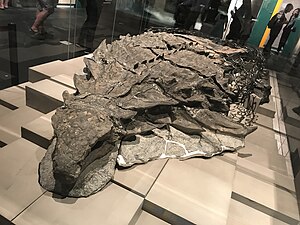Boreal Delta
| Boreal Delta | ||||||||||||
|---|---|---|---|---|---|---|---|---|---|---|---|---|

Exhibited holotype from Borealopelta |
||||||||||||
| Temporal occurrence | ||||||||||||
| Lower Cretaceous ( Aptium ) | ||||||||||||
| 126.3 to 112.9 million years | ||||||||||||
| Locations | ||||||||||||
|
||||||||||||
| Systematics | ||||||||||||
|
||||||||||||
| Scientific name | ||||||||||||
| Boreal Delta | ||||||||||||
| Brown et al. , 2017 | ||||||||||||
| Art | ||||||||||||
|
||||||||||||
Borealopelta is a genus of Nodosauridae within the bird basin dinosaur from the Lower Cretaceous of North America. The only known fossil was 2011 at the oil sands - surface mining of oil company Suncor Energy found and in media reports "Suncor Nodosaurier" ( English "Suncor nodosaur" ) called. The fossil is unusually well preserved and was in 2017 the only scientifically and type - type of the genus, Borealopelta markmitchelli , described .
Find history
Miners discovered the Borealopelta fossil on March 21, 2011 while working in Suncor Energy's Millennium Mine . The open pit is located in the Canadian province of Alberta , just under 30 kilometers north of Fort McMurray . The sands , i.e. the mineral substance of the Athabasca oil sands , and with them the skeleton of the Borealopelta were deposited in the Cretaceous period . The crude oil , which was degraded to bitumen due to its proximity to the surface , only later migrated from the depths into the sands. It took about two weeks to retrieve the fossil from the open pit, with some parts breaking off. The fossil was transported to the Royal Tyrrell Museum of Palaeontology and dissected . The fossil has been on display in this museum since May 2017. In November 2017, a new study was published, which allowed the skin color to be determined due to the good state of preservation of the fossil. Accordingly, the Borealopelta was colored reddish-brown on its body surface, while its underside had a light, white coloring, a coloring that is mostly typical for forest dwellers.
Analysis of the stomach contents
In addition to the well-preserved tank, the last meal has also been preserved in great detail. Analysis of the contents of the stomach, roughly the size of a soccer ball, showed that the herbivorous dinosaur ate predominantly ferns from the genus fern . Fern remnants make up 85%, 3% come from cycads and a very small part from conifers ; the rest could not be assigned to any plant group. Leaves made up about 88% of the plant material, less than 7% stems and wood, and about 6% charcoal.
The charcoal suggests the dinosaur ate its last meal in an area where it burned for the 6 to 18 months prior to its meal. Also Gastrolithe were found in the intestine. Due to the stage of maturity of the ferns, it is believed that the dinosaur died in late spring or early summer.
Web links
- Well-known dinosaur mummy - Panzersaurier camouflaged itself with red-brown paint Spiegel-Online
- A one-in-a-billion dinosaur find report by Donald M. Henderson, curator of dinosaurs at the Royal Tyrrell Museum
- Discovery of Ankylosaur at Suncor's Millennium Mine , documentation of the find on YouTube.
Individual evidence
- ↑ Caleb M. Brown, Donald M. Henderson, Jakob Vinther, Ian Fletcher, Ainara Sistiaga, Jorsua Herrera, Roger E. Summons: An Exceptionally Preserved Three-Dimensional Armored Dinosaur Reveals Insights into Coloration and Cretaceous Predator-Prey Dynamics . Current Biology. 3rd August 2017.
- ^ The Amazing Dinosaur Found (Accidentally) by Miners in Canada
- ↑ Brown CM. (2017) An exceptionally preserved armored dinosaur reveals the morphology and allometry of osteoderms and their horny epidermal coverings. PeerJ 5: e4066 doi: 10.7717 / peerj.4066
- ↑ Caleb M. Brown, David R. Greenwood, Jessica E. Kalyniuk, Dennis R. Braman, Donald M. Henderson, Cathy L. Greenwood, James F. Basinger: Dietary palaeoecology of an Early Cretaceous armored dinosaur (Ornithischia; Nodosauridae) based on floral analysis of stomach contents. In: Royal Society Open Science. 7, 2020, p. 200305, doi: 10.1098 / rsos.200305 .
